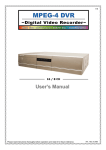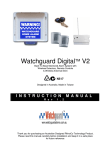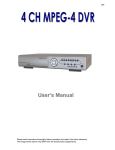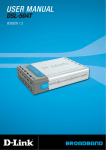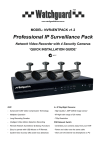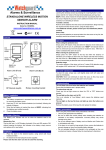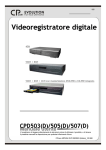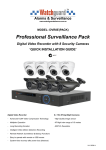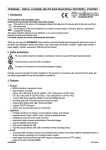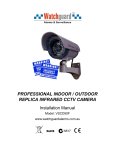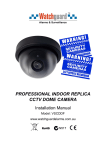Download Professional Surveillance Pack
Transcript
www.watchguardalarms.com.au MODEL: DVR4ENTPACK Professional Surveillance Pack Digital Video Recorder with 4 Security Cameras ‘USER MANUAL’ N517 DVR - Advanced MPEG4 Video Compression Technology 2 x Cameras – 30m night-vision range - High Quality CCD Image sensor - Multiplex Operation - 24 x IR LED’s - Long Recording Duration - 420 TVL Resolution, 520 x 582 Pixels - Intelligent Video Motion Detection Recording 2 x Cameras – 15m night-vision range - Remote Network Surveillance & Backup Functions - High Quality CCD Image sensor - Easy to operate like a VCR - 12 x IR LED’s - System Auto recovery after power loss (blackout) - 420 TVL Resolution, 520 x 582 Pixels Note: The latest version of this manual can be found at: http://www.watchguardalarms.com.au -1- Safety Warning CAUTION To reduce the risk of electric shock, do not expose this machine to rain or moisture. Only operate this machine from the type of power source indicated on the label. RhinoCo Technology shall not be liable for any damages arising out of any improper use, even if we have been advised of the possibility of such damages. The lightning flash with arrowhead symbol, within an equilateral triangle, is intended to alert the user to the presence of uninsulated “dangerous voltage” within the product’s enclosure that may be of sufficient magnitude to constitute a risk of electric shock to persons. This exclamation point within an equilateral triangle is intended to alert the user to the presence of important operating and maintenance (servicing) instructions in the literature accompanying the appliance. C-Tick & CE Mark This apparatus is manufactured to comply with the radio interference requirements. RhinoCo Technology does not warrant that this manual will be uninterrupted or error-free. We reserve the right to revise or remove any content in this manual at any time. THIS PRODUCT IS LICENSED UNDER THE MPEG-4 VISUAL PATENT PORTFOLIO LICENSE FOR THE PERSONAL AND NON-COMMERCIAL USE OF A CONSUMER FOR (i) ENCODING VIDEO IN COMPLIANCE WITH THE MPEG-4 VISUAL STANDARD (“MPEG-4 VIDEO”) AND/OR (ii) DECODING MPEG-4 VIDEO THAT WAS ENCODED BY A CONSUMER ENGAGED IN A PERSONAL AND NON-COMMERCIAL ACTIVITY AND/OR WAS OBTAINED FROM A VIDEO PROVIDER LICENSED BY MPEG LA TO PROVIDE MPEG-4 VIDEO. NO LICENSE IS GRANTED OR SHALL BE IMPLIED FOR ANY OTHER USE. ADDITIONAL INFORMATION INCLUDING THAT RELATING TO PROMOTIONAL INTERNAL AND COMMERCIAL USES AND LICENSING MAY BE OBTAINED FROM MPEG LA, LLC. About This Manual This user manual covers the menu system and network functionality of your digital video recorder (DVR). Please refer to the included Quick Installation Guide for information on: • • • • • • • Package contents. Unpacking and connecting your DVR system. Setting the date and time. Starting and stopping recording. Searching and playing back recorded footage. Using the Keylock feature. Troubleshooting -2- Table of Contents Safety Warning .................................................................................................................................................................... 2 About This Manual .............................................................................................................................................................. 2 Table of Contents ................................................................................................................................................................ 3 Menu System .......................................................................................................................................................................... 4 Navigating the Menu ........................................................................................................................................................... 4 Menu Tree ........................................................................................................................................................................... 5 Record ................................................................................................................................................................................. 6 Timer ................................................................................................................................................................................... 7 Date ..................................................................................................................................................................................... 7 Advance .............................................................................................................................................................................. 8 Advance > Camera ............................................................................................................................................................. 8 Advance > Detection ........................................................................................................................................................... 8 Advance > Detection > Detection Setup ............................................................................................................................. 8 Advance > Detection > Detection Timer ........................................................................................................................... 10 Advance > Display ............................................................................................................................................................ 10 Advance > Alert ................................................................................................................................................................. 11 Advance > Remote ............................................................................................................................................................ 12 Advance > System ............................................................................................................................................................ 13 Advance > Network ........................................................................................................................................................... 14 Advance > HDD Info ......................................................................................................................................................... 14 Advance > Event Log ........................................................................................................................................................ 14 Section 2 – Network Operation ............................................................................................................................................. 15 Introduction ........................................................................................................................................................................ 15 Default DVR Network settings ........................................................................................................................................... 15 Connecting via AP Software ............................................................................................................................................. 15 Playback Operation ........................................................................................................................................................... 16 Playback Operation ........................................................................................................................................................... 17 System Config > Network > Dynamic DNS ...................................................................................................................... 19 System Config > Network > Mail ....................................................................................................................................... 19 System Config > Network > FTP ....................................................................................................................................... 20 System Config > DVR ....................................................................................................................................................... 20 System Config > Device .................................................................................................................................................... 20 System Config > Detection................................................................................................................................................ 21 System Config > DVR > Network Backup ......................................................................................................................... 22 System Config > DVR > Search List ................................................................................................................................. 23 System Config > DVR > Timer Record ............................................................................................................................. 23 System Config > DVR > Record Setting ........................................................................................................................... 24 System Config > Alarm ..................................................................................................................................................... 25 System Config > General .................................................................................................................................................. 25 System Config > General > Account ................................................................................................................................. 26 System Config > General > Online User Info .................................................................................................................... 27 System Config > General > File Path ................................................................................................................................ 27 Troubleshooting................................................................................................................................................................. 28 Connecting via Internet Explorer ....................................................................................................................................... 29 RS-232 Protocol ................................................................................................................................................................ 32 Hard Drive Installation ....................................................................................................................................................... 33 Section 3 - Remote Setup Guide .......................................................................................................................................... 34 Introduction ........................................................................................................................................................................ 34 General Connection Information ....................................................................................................................................... 34 Configuration of a D-link DSL504T (v2) for use with the DVR .......................................................................................... 34 Initial Router Setup ............................................................................................................................................................ 34 Dynamic DNS .................................................................................................................................................................... 34 DVR IP Address ................................................................................................................................................................ 35 LAN Clients ....................................................................................................................................................................... 35 Port Forwarding ................................................................................................................................................................. 36 Connecting Remotely ........................................................................................................................................................ 36 -3- Menu System Navigating the Menu The following buttons are used to navigate through the menu. MENU ENTER + UP RIGHT LEFT DOWN -4- - Menu Tree The menu system for the DVR can be reached by pressing the MENU button. The menu system has the following structure. MEN TITLE RECO T I ME DAT ADVANC BRIG CAMER CONT DATE: YEAR MONTH SATU MANUAL RECORD DATE EVENT RECORD START HH : MM TIME: HOUR MIN SEC COV TIMER RECORD END HH : MM FORMAT: Y-M- REC HUE DETECTI DAYLIGHT DET OVERWRITE RECORD IMG AREA DISPL LS ALE RECORD TITLE MANUAL RECORD IPS DATE EXT. HDD INT. LOSS KEY EVENT RECORD IPS TIMER RECORD TOTAL IPS TITLE PLAYBAC K INFO DWELL DURATION (SEC) SS REMO RE ALARM VLOSS MO T I O N ALARM SYSTE BAUD DEINTERLAC HDD NEARLY FULL (GB) HOST MONITOR OUT ALARM DURATION TITLE DEVICE IR RESET CLEAR UPGRADE NETWO R.E.T.R. AUTO HDD EVENT LANGUAG VERSION VIDEO -5- ID PASSWO PRE-ALARM WATERMA DETECTIO N TIMER SERIAL HDD BUZZER OSD TS PROTOC RATE Record RECORD MANUAL RECORD ENABLE EVENT RECORD ENABLE TIMER RECORD ENABLE OVERWRITE RECORD IMG SIZE RECORD QUALITY MANUAL RECORD IPS EVENT RECORD IPS TIMER RECORD IPS TOTAL IPS SHARE Manual Record Enable Indicates whether the DVR has been manually set to record. If you have pressed the REC button on the front panel to start recording, then this will say YES. You can start or stop recording manually, by changing this value to either YES or NO. Event Record Enable Sets whether the DVR should start recording when motion is detected or the external alarm is triggered. For more information on motion detection and external alarms see Advance > Detection Timer Record Enable Sets whether the DVR should use the timer schedule to start and stop recording. Overwrite Sets whether the DVR should automatically overwrite the oldest footage when the hard drive becomes full. Record IMG Size Sets the resolution the DVR will record in. Recording in FRAME mode forces the DVR into MJPEG and will use approximately 5 times as much space as CIF mode. FRAME (MJPEG) CIF (MPEG4) 704 x 576 pixels 352 x 288 pixels Record Quality Sets the quality to record in. It is best to experiment with these settings to find a quality level that suits you. There are four options available – BEST, HIGH, NORMAL and BASIC. Note: The images per second (IPS) settings are global. This means that if you have the IPS set to 100, each camera will record at 25 IPS. Likewise, a setting of 12 would have each camera record at 3 IPS. Manual Record IPS Sets how many IPS the DVR will record in when manually set to record by the user. Event Record IPS Sets how many IPS the DVR will record in when it detects motion or is triggered by an external alarm. Timer Record IPS Sets how many IPS the DVR will record in when it is recording off the timer schedule. Total IPS Share This option does not apply to this model DVR. -6- Timer RECORD DATE OFF DAILY SUN MON-FRI OFF OFF OFF START 00 : 00 08 : 00 06 : 00 00 : 00 00 : 00 00 : 00 00 : 00 - END 00 : 18 : 23 : 00 : 00 : 00 : 00 : 00 00 00 00 00 00 00 Using the Timer menu you can setup multiple recording schedules. The DATE specifies what days the schedule applies. The START and END times indicate (in 24 hour format) when the DVR will record. Note: The DVR will only use the timer schedule if the Record > Timer Record Enable option is set to YES. Date DATE DATE 2006-MAY-12 16:30:00 FORMAT Y-M-D DAYLIGHT SAVING ON The Date menu is used to set the date, time and daylight savings settings for the DVR. Note: Never change the date and time when the DVR is recording - stop recording before hand. The daylight savings option will tell the DVR to adjust the time during a certain date range. DAYLIGHT SAVING START END ADJUST 4TH-SUN-MAR 01: 00: 00 4TH-SUN-OCT 01: 00: 00 01 : 00 Example - In the image above: During the daylight savings time period (starting on the 4th Sunday of March and ending on the 4th Sunday of October), the DVR time will run one hour ahead. -7- Advance ADVANCE CAMERA DETECTION DISPLAY ALERT REMOTE SYSTEM NETWORK HDD INFO EVENT LOG Note: The Advance menu of the DVR is enthusiasts or experts only. Changing settings in this section of the menu can drastically alter the performance and functionality of the DVR. It is recommended you do not change anything in this section unless you know what you are doing. Advance > Camera Title This option allows you to create a name for the camera. Brightness / Contrast / Saturation / Hue This option allows you to modify these four values for the camera. Covert This option allows you to hide a camera from display. It will still record, but will only show during playback. Record This option allows you to configure whether to record this camera or leave it as display only. Advance > Detection DETECTION DETECTION SETUP DETECTION TIMER Advance > Detection > Detection Setup DETECTION TITLE 01 02 03 04 DET ON ON ON ON AREA LS SETUP 07 SETUP 07 SETUP 07 SETUP 07 SS 03 03 03 03 TS 02 02 02 02 RE 10 10 10 10 ALARM OFF LOW HIGH OFF Detection This option enables and disables motion detection for this individual camera. Area Press ENTER to setup area masking for this camera. -8- Press “ENTER” to confirm the start area Press ◄ or ► to choose the width of the area Press ▲ or ▼ to choose the height of the area, and press “ENTER” again to confirm. Multi-detection areas Press “-” to set the whole area under detection Press “+” to set the whole undetected LS The sensitivity of comparing two different images. The smaller the value is, the higher sensitivity for motion detection. The highest sensitivity setting is 00 and the lowest sensitivity setting is 15. The default value is 07. SS The sensitivity regarding the size of the triggered object on the screen (the number of motion detection grids). The smaller the value, the higher sensitivity for motion detection. The highest sensitivity setting is 00 and the lowest sensitivity setting is 15. The default setting is 03. Note: The default setting of Spatial Sensitivity is 03, which means once a object is detected more than 3 grids, the system will get triggered. So the value of Spatial Sensitivity must be less than the number of grids that you set up for the motion detection area. TS The sensitivity regarding how long the object gets triggered. The smaller the value, the higher motion detection sensitivity will be. The highest sensitivity setting is 00 and the lowest sensitivity setting is 15. The default setting is 02. RE The value of RE is a reference for detection. The default value is 10, which means DVR will compare 10 continuous images at one time according to the sensitivity of LS, SS, TS simultaneously. The bigger the value, the higher sensitivity for motion detection. The highest sensitivity is 61. Alarm Select LOW / HIGH for the alarm. The default alarm value is OFF. -9- Advance > Detection > Detection Timer DETECTION TIMER DATE OFF DAILY SUN MON-FRI OFF OFF OFF START 00 : 00 08 : 00 06 : 00 00 : 00 00 : 00 00 : 00 00 : 00 - END 00 : 18 : 23 : 00 : 00 : 00 : 00 : 00 00 00 00 00 00 00 The DVR will only check for alarm inputs or motion when in a scheduled time period. Advance > Display DISPLAY TITLE DISPLAY DATE DISPLAY HDD INFO LOSS SCREEN PLAYBACK INFO DWELL DURATION (SEC) DE-INTERLACE MONITOR OUT OSD WATERMARK ON ON ON BLUE NORMAL 2 ON MAIN SETUP ON Title Display / Date Display Configures whether or not to show camera title and date information on screen. HDD Info This option configures whether or not to show the current hard drive capacity on screen. Loss Screen Configures whether to show a BLUE or BLACK screen when video loss is detected. Playback Info This option configures whether to show playback info in the bottom left (NORMAL) or center (CENTER). Dwell Duration This option configures how long the DVR should ‘dwell’ on each camera when it is in sequencing mode. De-Interlace This option configures whether the monitor output is de-interlaced. Monitor Out This DVR does not support multiple output monitors. Do not change this value. OSD This sub menu lets you customise the colour values of the on-screen display. Watermark This option places a security watermark in stored video. It is recommended that you leave this option turned on. - 10 - Advance > Alert ALERT EXT. ALERT INT. BUZZER KEY BUZZER VLOSS BUZZER MOTION BUZZER ALARM BUZZER HDD BUZZER HDD NEARLY FULL (GB) ALARM DURATION (SEC) PRE-ALARM ON ON ON ON ON ON ON 05 05 OFF External Alert Configures whether to sound the buzzer when the external alarm is triggered. Internal Buzzer Sets the sound of the internal buzzer. Key Buzzer Configures whether to sound the buzzer when pressing buttons on the front panel. Video Loss Buzzer Configures whether to sound the buzzer when video loss is detected. Motion Buzzer Configures whether to sound the buzzer when motion is detected. Alarm Buzzer Configures whether to sound the buzzer when the internal alarm is triggered. HDD Buzzer Configures whether to sound the buzzer when the hard drive is full. HDD Nearly Full (GB) Sets the amount of remaining hard drive capacity required before the alarm will sound. Alarm Duration (SEC) Sets the amount of time to record once an alarm event has been detected. Pre-Alarm Sets whether the DVR should record events before an alarm trigger occurs. - 11 - Advance > Remote REMOTE TITLE 01 02 03 04 DEVICE PTZ CAMERA CAMERA CAMERA ID 001 002 003 004 PROTOCOL P-D NORMAL NORMAL NORMAL RATE 02400 02400 02400 02400 Note: This section of the menu is for configuring the DVR to send PTZ commands to cameras. Please note that the cameras supplied with this DVR do not support this feature. If you wish to use a PTZ camera with this DVR, the camera must support the Pelco-D protocol. For more information on setting up a PTZ camera, refer to your cameras manual. Device Configures whether the camera attached to this channel is a NORMAL or PTZ camera. ID Configures the PTZ ID of the camera. Range of 1 ~ 255. Protocol Configures the protocol for the camera as either NORMAL or Pelco-D P-D. Rate Configures the baud rate used by the camera as either 2400, 4800, 9600, 19200, 57600. Connection Guide Connect “RS485-A” line (brown colour) to RS485-A port on the rear panel of the DVR. Connect “RS485-B” line (orange colour) to RS485-B port on the rear panel of the DVR. - 12 - Advance > System SYSTEM SERIAL TYPE BAUD RATE HOST ID PASSWORD RESET DEFAULT CLEAR HDD AUTO KEYLOCK LANGUAGE VERSION VIDEO FORMAT RS - 485 02400 003 SETUP RESET MASTER NEVER ENGLISH 1088-10-K2-04-AA-11 NTSC Serial Type Switches the serial type of the DVR between RS-232 and RS-485. Baud Rate Switches the baud rate of the DVR between 2400, 9600, 19200 and 57600. Host ID Sets the ID of the DVR. Range of 1 ~ 255. Password Modifies the admin and guest passwords for the machine. Reset Default Resets the system to the factory default setting. Note: Your DVR has been pre-configured to record for 4 weeks. This is not the factory default setting. Clear HDD Erases all recorded footage off the hard drive. Auto Keylock Configures the DVR to automatically turn the keylock on after 10, 30 or 60 seconds. Set to NEVER to disable this feature. Language Configures the language of the on-screen display. Version The current firmware version of the DVR. Video Format This option switches the video format between PAL and NTSC. Australia uses the PAL system. - 13 - Advance > Network Note: If you do not have a thorough understanding of TCP / IP technology it is recommended that you employ the services of a network technician to help you. For more information on setting up the remote connection component, please see Section 3 of this manual. NETWORK NETWORK TYPE DNS PORT STATIC 203 . 021 . 020 . 020 0080 Network Type Configures whether the DVR uses a Static IP, DHCP or PPPoE network connection. After choosing which type of connection to use, press the ENTER button to enter the relevant information for each type. DNS Set the DNS server for the DVR. Port Set the Port that the DVR should run on. Default is 80. Advance > HDD Info This section of the menu shows you the remaining capacity of the internal hard drive. HDD INFO HDD NUM MASTER-1 MASTER-2 EXT001 EXT003 EXT005 EXT007 EXT009 EXT011 HDD SIZE 080.000 NO HDD NO HDD NO HDD NO HDD NO HDD NO HDD NO HDD HDD NUM SLAVE-1 SLAVE-2 EXT 002 EXT 004 EXT 006 EXT 008 EXT 010 EXT 012 HDD SIZE NO HDD NO HDD NO HDD NO HDD NO HDD NO HDD NO HDD NO HDD Advance > Event Log This section of the menu allows you to view lists of system events, such as video loss, network access, etc. EVENT LOG VLOSS NET SYSTEM OTHERS CLEAR - 14 - LIST LIST LOG ALL Section 2 – Network Operation Introduction There are two ways you can remotely connect to your DVR. The first method is to connect using the AP software. This must be installed on your computer. The second method is to connect using Internet Explorer. Either method requires that Windows networking has been set up correctly for the DVR prior to connection. Refer to the Microsoft Windows documentation or contact an IT Professional for more information. Default DVR Network settings Username: Password: IP Address: Port: admin admin 192.168.0.1 80 Connecting via AP Software Install AP Software You can obtain the AP software from the supplied CD-ROM or by browsing to http://www.watchguardalarms.com.au/dvr4entpack.php and following the directions on the page. Note: Refer to page 14 on information regarding checking / altering the DVR’s network settings. AP Software – Login Screen Open Backed Up footage Copy AP Software Settings Search for DVR Upgrade Firmware DVR List Username Password IP Address Port Login Exit - 15 - AP Software – Camera Screen The AP software works by emulating the buttons on the front panel of the DVR. Anything you can do on the DVR can also be done in the AP software. a) Frame Rate b) Data Rate (bandwidth being used) c) Connect / Disconnect from DVR d) Switch display resolution between 320 x 276 and 640 x 552. e) Image Quality (High, Medium, Low) f) Take a Snapshot. Saved in the location set in System Config > General > File Path > Snapshot Path. g) Start and stop recording. Saved in the location set in System Config >General > File Path > Record Path. This will record what you see on screen to your own computer. h) Open the System Config menu. i) The number of users connected to the DVR. j) Theses buttons all emulate the front panel of the DVR. Please refer to the quick installation guide and the menu section above. Hover your mouse cursor over the button to get a description of what it does. a c d e b j. - 16 - f g h i Playback Operation One click to activate • De-interlace • De-blocking • OSD • AVI Convert • Config. Setting • Watermark • Open Previous File • Open Next File A • B C Playback Information : Display information such as “Date”, “Time”, “Resolution”, “ Rewind / Forward Speed”, “Status” and “Functions”, etc. Time Progress Bar : Show the playback progress status. F u n c ti o n s : • • D E F To snap a video clip, right click the mouse to make a starting point (red) and click one more time to make a ending point. Then right click to convert to the AVI format. De-interlace: Reduce the vibration of the paused picture. De-blocking: Reduce the video mosaic phenomenon. OSD: Display the OSD of the AP playback window. AVI conversion: Convert the entire recorded file to the AVI format. Config. Setting: Enter the AP config. setting box, and set the file path, text color and text color of progress status. * Mute: Play back the video only (without audio). * AV Sync.: Play back with the audio and video synchronously. Watermark: Proof the authenticity of the backup video. Open Previous File: Open the previous backup video. Open Next File: Open the next backup video. • • • Playback Control Buttons : Play / Stop / Pause / Fast Rewind / Fast Forward Snapshot : Press this button to take a snapshot of the current image which will be saved in the designated destination. Close the Player Note: • When users pause the playback picture, press “ ” button to go to the previous frame, or press “ ” button to go to the next frame. • In the playback mode of the software AP, users could press ” “ button to check the authenticity of the BACKUP VIDEO. If the BACKUP VIDEO had been altered, the video image will turn to light red and the playback will be paused. Note: • When users use remote AP recording, the watermark function is not supported. - 17 - System Config > Network Press the button to enter the System Config. The network configuration allows the DVR to connect to an Ethernet or dial-up network. Static IP: Enter the “server IP”, “gateway”, “net mask” and “web port”, and then press “APPLY” to confirm. PPPOE: Enter the “username” and “password” provided by your ISP (Internet Service Provider). Then, go to “DDNS” and finish DDNS settings before pressing “APPLY”. DHCP: This DHCP function needs to be supported by a router or a cable modem network with DHCP services. Choose the DHCP IP type. Then, go to “DDNS” and finish DDNS settings before pressing “APPLY”. Note: PPPOE and DHCP network connection types are required to apply DDNS services FIRST to get a “H Hostname” to correspond to the dynamic IP address Some router brands may need to restart the DVR to get the IP address. Web Port: The DVR can be viewed over the network with the software AP or a web browser. Typically, the TCP port used by HTTP is 80. However in some cases, it is better to change this port number for added flexibility or security. The valid number ranges from 1 to 9999. - 18 - System Config > Network > Dynamic DNS DDNS is a service for transforming the dynamic IP corresponding to a specific “Hostname”. DDNS Apply: Go to a website which provides free DDNS services and apply a “Hostname”. See the example below. Enable the DDNS function: User Name: Enter your DDNS user name. Password: Enter your DDNS password. Domain: Enter your host name. System Name: Choose the DDNS system name you use from the drop-down list. After setting, press “APPLY” to confirm. Note: If the dial-up static IP is provided by your ISP, simply choose “Enable” and do not need to enter the information described above. Auto: When using DHCP network connection, the "AUTO" check box will appear on this window. The system will automatically get DNS information from the Internet if this check box is selected. System Config > Network > Mail When the recording is triggered by an alarm or a motion, a video copy file can be captured. The DVR will send an e-mail notification to the assigned recipients (up to 5 recipients). ***Note***: To activate the e-mail notification function, please enable the function of e-mail notification in the “Alarm” setting first (page 26). Add the recipients’ email accounts in “Mail Account” column. 4CH DVR For detailed information (SMTP server, username and password), please get from your e-mail system supplier. Please type the entire email address in the “Mail from” column to ensure emails will not be blocked by SMTP. In some cases, mail servers require to verify password. Please enter the “user name” and “password”. After finishing the settings, press “APPLY” to confirm. - 19 - System Config > Network > FTP When the recording is triggered by an alarm or a motion, a video copy file can be captured. And the DVR will upload the captured images to the assigned FTP site. Enter the detailed FTP information. ***Note***: To activate the FTP notification function, please enable the function of FTP notification in the “Alarm” setting first. (Refer to Pg 26). After setting, press “APPLY” to confirm. 4CH DVR System Config > DVR Each camera channel can be adjusted independently. Select the desired camera channel. Press “E Edit” to enter the setting box. Title: Enter the camera channel name up to 6 characters. Adjustment: Adjust the BR (brightness) / CT (contrast) / SU (saturation) / HU (hue) / REC (recording) of the camera. After setting, press “OK” and then press “APPLY” to confirm. System Config > Device Select the desired channel of the installed external device. Press “E Edit” to enter the setting box. Device Type: Choose either general camera or PTZ camera. ID No. : Set the ID number (0 ~ 255) of the installed external PTZ device. Protocol Type : Choose “N NORMAL” protocol for our own brand camera. Choose “P P-D” protocol for PELCO-D protocol camera. Baud Rate : Set the baud rate of each channel (2400, 4800, 9600, 19200, 38400, 57600, 115200). After setting, press “OK” and then press “APPLY” to confirm. - 20 - System Config > Detection Select the desired channel, and press “E Edit” to enter the motion detection sensitivity and area setting box. Motion Detection Sensitivity: Set the detection sensitivity in 4 different adjustable factors. LS: The sensitivity of comparing two different images. The smaller the value, the higher sensitivity for the motion detection. SS: The sensitivity towards the size of the triggered object on the screen (the number of motion detection grids). The smaller the value, the higher sensitivity for the motion detection. TS: The sensitivity towards how long the object stays in the detection area to get triggered. The smaller the value, the higher sensitivity for the motion detection. RE: The value of RE is a reference for the detection. The bigger the value, the higher sensitivity for the motion detection. Alarm: Select LOW / HIGH for the alarm polarity. Motion Detection Area: By clicking the area with your mouse, one can choose the motion area to be detected. The under detected area is transparent while the undetected area is in pink color. *Click “Select All” to activate the detection area as the full area. *Click “Clear All” to clean the previously selected detection area. After setting, press “OK” and then press “APPLY” to confirm. - 21 - System Config > DVR > Network Backup You can backup the recorded data from the DVR directly to your PC and CD-R disk via the network. The backup file can be played directly in your PC via the supplied licensed AP, or via other media players (Ex: Windows Media Player or RealPlayer) after the file is converted to “AVI” format. NOTE: For CD backup, please install “NERO” CD burning program to your PC first. 1. Enter the backup information: If you want to make a backup to a CD, please check “Copy to CD”. If you want to view the backup image while the backup is processing, please check “Dynamic Download”. 2. Press "Start" button to proceed the backup process. Making backup to your PC: After pressing “Start”, the backup will begin and a status bar will be displayed. The “DVR Network Backup” pop-up window will show the message “Download process is finished” when the backup has succeeded. Press “PLAY” button to directly convert and play the file, or “Exit” to quit. To convert the backup file later, please find the file in the designated file path and double-click it twice for AVI conversion and file playback. - 22 - System Config > DVR > Search List HDD Number: Select one HDD (Master). List Type: Select one list type (All/ Manual/ System/ Alarm/ Motion). Max List Number: Maximum number of the list (128) Download HDD List: Press this button to start downloading the list. 4CH DVR System Config > DVR > Timer Record In this menu, you can schedule 7 different sets of time for recording. DATE: Choose a day from “DATE” dropdown menu. The options are OFF, SUN, MON,TUE, WED, THU, FRI, SAT, MON-FRI, SAT-SUN and DAILY. START: Enter the start time of timer recording. END: Enter the end time of timer recording. 4CH DVR Press “APPLY” if the settings are correct; press “EXIT” to quit without saving. - 23 - System Config > DVR > Date In this menu, The DVR’s date can be set. Please DO NOT change the date or time when the recording function is activated. DATE: Choose the current date from “DATE” drop-down menu and enter the current time. When you click the drop-down menu, a calendar as shown below shows for you to set the current date. 4CH DVR FORMAT: Choose the format for date display from the three options: Y-M-D, D-M-Y and M-D-Y. DAYLIGHT SAVING: Specify whether to use daylight saving time (ON / OFF) and time period (START / END), and adjust the daylight saving time in hour (ADJUST). System Config > DVR > Record Setting In this menu, you can set DVR record settings. MANUAL RECORD: Specify whether to use manual recording (YES / ON) and set IPS number. EVENT RECORD: Specify whether to user event recording (YES / ON) and set IPS number. TIMER RECORD: Specify whether to use timer recording (YES / ON) and set IPS number. OVER WRITE: Specify whether to overwrite the HDD capacity when the HDD is full (YES / NO). RECORD IMG SIZE: Choose “FRAME” or “CIF”. This selection will affect the available IPS options in the 3 recording modes described above. 4CH DVR RECORD QUALITY: 4 options are available from the drop-down menu: BEST, HIGH, NORMAL and BASIC. TOTAL IPS SHARE: Choose the IPS share as FIX or GROUP. - 24 - System Config > Alarm Alarm Trigger: Enable or disable Email and FTP notification function. Alarm Method: Two notification methods — Email and / or FTP. Post Numbers: Set MJPEG pictures (1-10 pictures). Alarm Duration: Set the duration time of motion trigger recording (5 SEC, 10 SEC, 20 SEC, 40 SEC). Alarm Refresh: Clean the alarm message “ ” which is shown on the screen. 4CH DVR Note: Email Notification: MJPEG pictures will be made at your designated space set in “File Path”, plus an e-mail contained with the MJPEG pictures (1-10 pictures) to be sent to the address which is set under “Mail”. FTP Notification: MJPEG pictures will be made at your designated space set in “File Path”, plus a FTP file contained with the MJPEG pictures (1-10 pictures) to be sent to the address which is set under “FTP”. System Config > General Get the information of the DVR firmware version in this window. Select “TURBO” Step” (1 - 10) To speed up menu selection or the control of the PTZ camera under video web servers, users can activate "TURBO" function by clicking this button. Users are allowed to change the turbo steps from 1 to 10. Ex: If the value of turbo step is “5“, it means that when users press one of the button up/down/left/right, one click is as clicking 5 times. MAX LOG LIST: Set the maximum number of log list. Server Log: Press “Server Log” button to enter the server log list window. Title Title: Name the title which will be shown on the top of the AP live viewer (up to 15 characters). - 25 - System Config > General > Account Set up the user’s account (Max 5 accounts), password, life time, and authority level (M Max 5 users on line at the same time). User’s level: SUPERVISOR — Control all the functions (“a”, “b”, “c”, “d”, “e” and “f” ). HIGH — Control only “a”, “b”, “c”, “d” and “e” functions, but cannot control “f” function. NORMAL — Control only “a”, “d”, and “e” functions, but cannot control “b”, “c” and “f” functions. GUEST — Watch the image only. Only “a” function can be used. L i fe ti m e : According to different authority levels, different accounts can stay online for different time periods (1 Min, 5 Min, 10 Min, 1 Hour, 1 Day, INFINITY). a - 26 - b c d e f System Config > General > Online User Info Get all the current online users’ information list (Name, IP Address, Authority Level, Resolution and Image Quality). System Config > General > File Path Snapshot Path: Assign the route for saving the snapshot picture. Record Path: Assign the route for saving the manually recorded file. - 27 - Troubleshooting PROBLEM No power Not working when pressing any button Timer record is not working No live video No recorded video DVR keeps rebooting HDD detection failed Can’t detect your USB flash drive Can’t view the DVR images over the network with IE web browser Can’t play the recorded data on my DVR SOLUTION Check power cord connection. Confirm that there is power from the outlet. Press any key and then enter the password to exit “Key Lock” mode. Check if the “TIMER RECORD ENABLE” is set to “YES”. Check the camera’s video cable and connections. Check the monitor’s video cable and connections. Confirm the camera is power supplied. Check the setting of the camera lens. Check if the HDD is installed and connected properly. Make sure the power connector and HDD are connected closely, or change another suitable HDD. Change another HDD for testing. Change another HDD cable for testing. Make sure HDD “Master”, “Slave” mode is correctly set. Change another USB flash drive to test. Update the JAVA program. Update the firmware of the software AP. There must be at least 8192 images of recorded data for playback to work properly. If not, your DVR will stop the playback. For example, if the IPS is set to 30, the recording time should be at least 273 seconds (8192 images / 30 IPS) for the playback to work properly. Error Code in “SYSTEM LOG”: Meaning: 1) SYS ERR 01-YYY #define SYS_ERR_AV087_ERR Compression error YYY=000 Audio chip error YYY=001- AV087 Chip for CH1-4 error YYY=002- AV087 Chip for CH5-8 error YYY=004- AV087 Chip for CH9-12 error YYY=008- AV087 Chip for CH13-16 error YYY=003(001+002) Chips for CH1-4 & CH5-8 error, etc 2) SYS ERR 02-XXX #define SYS_ERR_AV087_BUF_FULL Buffer is full 3) SYS ERR 03-XXX #define SYS_ERR_AV087_BUF_EMPTY Buffer is empty 4) SYS ERR 04-XXX #define SYS_ERR_IDE_ERR IDE interface error 5) SYS ERR 05-XXX #define SYS_ERR_SCAN_DISK Disk scanning error 6) SYS ERR 06-XXX #define SYS_ERR_TOP_FAT_ERR File system error 7) SYS ERR 07 (including 08, 09, etc.)-XXX #define HDD error - 28 - Connecting via Internet Explorer Install Java Runtime Environment Before you can view your DVR in Internet Explorer you must have the Java Runtime Environment installed. This is supplied on the included CD. To install the Java Runtime Environment: Insert the included CD into a computer running Windows 2000 or later. Open the Start menu and press Run. In the Open box type D:\Java.exe and press OK. Follow the on screen prompts to install the Java Runtime Environment. Note: Replace D with the letter of your CD or DVD drive. Connecting to the DVR To log into the DVR you need to type the following address into Internet Explorer: http://<ip-address>:<port> You will need to replace the <ip-address> and <port> with the values from the Advance > Network section of the menu. For example using the default values, the address would be: http://192.168.0.1:80 The following screen will then show. You can now login using the administrator account. The default username and password are admin and admin. - 29 - Internet Explorer Operation Using the core elements of DVR in Internet Explorer is very similar to using the AP software. For further information, please refer to the AP software instructions Change Resolution PTZ Change Image Quality Same as the AP software operation. Sets the display position of the image (LT: Upper Left; LD: Lower Left; RT: Upper Right; Lower Right) - 30 - Pin Configuration PIN 1 2 3~6 7 8 9 10 11 12~13 14 15 16~17 FUNCTION RS232-TX DESCRIPTION DVR can be controlled remotely by the keyboard of PC by using RS-232 serial communication signals. RS232-RX DVR can be controlled remotely by the keyboard of PC by using RS-232 serial communication signals. ALARM INPUT To connect the wire from ALARM INPUT ( PIN 3 -- 6 ) to GND ( PIN 9 ) connector, DVR will start recording and the buzzer will be on. When “MENU -> CAMERA -> ALARM” is set to “Low” : When the alarm input signal is “ Low ”, the unit starts to record and buzzer. When “MENU -> CAMERA -> ALARM” is set to “High” : When the alarm input signal is “ High ”, the unit starts to record and buzzer. EXTERNAL ALARM NC Under the normal operation, COM connects with NC and disconnects from NO. But when any alarm is triggered, COM disconnects with NC and connects with NO. Attention: The voltage restriction is under AV/DC 30V. EXTERNAL ALARM Under the normal operation, COM disconnects with NO. But when any alarm is NO. triggered, COM connects with NO. Attention: The voltage restriction is under AV/DC 30V. GND Signal GND. RS485-B DVR can be controlled remotely by the keyboard of PC by using RS-485 serial communication signals. RS485-A DVR can be controlled remotely by the keyboard of PC by using RS-485 serial communication signals. PIN OFF ALARM RESET Connecting the wire from ALARM RESET (PIN 14) to GND (PIN 9) connector will disable alarms. An external signal to ALARM RESET (PIN 14) can be used to reset both ALARM OUTPUT signal and DVR’s internal buzzer. When any alarm has been triggered, the signal becomes “Low”, and all alarm activities will be stopped. Under the normal operation, the signal remains “High”. EXTERNAL ALARM Under the normal operation, COM disconnects with NO. But when any alarm is COM triggered, COM connects with NO. Attention: The voltage restriction is under AV/DC 30V. GND Earth GND DC12V + When the magnetic contact is opened, the alarm will be triggered and the recording is on. At the same time, COM connects with NO and the siren with strobe starts wailing and flashing. Solder Side of DSUB 15PIN GND 8 NOTE: Please go to MENU -> ADVANCE -> DETECTION -> DETECTION SETUP, and set ALARM to LOW on the local machine. 7 6 5 4 3 2 1 15 14 13 12 11 10 9 16 17 PIN Connection Application - 31 - RS-232 Protocol • • Use PC keyboards to simulate DVR keypads. Data: REMOTE PROTOCOL use 8 bit data, 1 start bit, 1 stop bit. ACT (FFH) C0H ID FUNCTION STOP (7FH) FUNCTION CODE ASCII FUNCTION CODE ASCII KEY_MENU 0x4D M KEY_DWELL 0x65 e KEY_ENTER 0x0D ENTER KEY_CH1 0x31 1 KEY_PLUS 0x6b k KEY_CH2 0x32 2 KEY_MINUS 0x6d m KEY_CH3 0x33 3 KEY_UP 0x55 U KEY_CH4 0x34 4 KEY_DOWN 0x4E N KEY_CH5 0x35 5 KEY_LEFT 0x4C L KEY_CH6 0x36 6 KEY_RIGHT 0x52 R KEY_CH7 0x37 7 KEY_POWER 0x57 W KEY_CH8 0x38 8 KEY_REC 0x72 r KEY_CH9 0x39 9 KEY_PLAY 0x50 P KEY_CH10 0x41 A KEY_SLOW 0x53 S KEY_CH11 0x42 B KEY_ZOOM 0x5A z KEY_CH12 0x43 C KEY_KEY LOCK 0x4B K KEY_CH13 0x44 D KEY_AUDIO 0x64 d KEY_CH14 0x45 E KEY_SEARCH 0x73 S KEY_CH15 0x46 F KEY_PTZ_MODE 0x70 p KEY_CH16 0x47 G KEY_PTZ_PRESET 0x71 q KEY_EJECT_DVD 0x6a j KEY_PTZ_ZOOM_IN 0x69 i KEY_IRIS_NEAR 0x67 g KEY_PTZ_ZOOM_OUT 0x66 f KEY_IRIS_FAR 0x68 h KEY_MODE 0x6f o KEY_PTZ_LIGHT 0x6c l KEY_4 CUT 0x61 a KEY_PTZ_WIPER 0x77 w KEY_9 CUT 0x62 b KEY_16 CUT 0x63 c KEY_SET_CHANNEL 0x6e n - 32 - Hard Drive Installation Unscrew the two screws respectively on the two sides of the upper cover. Unscrew the four screws on the back side of the upper cover. Make sure your hard drive is set to Master. Refer to the hard drive manufacturer’s website if you are unsure. Mount the hard drive in the internal bracket and attached the power and data cables. Fig. 1 Fig. 2 Fig. 3 - 33 - Fig. 4 Fig. 5 Section 3 - Remote Setup Guide Introduction This guide covers how to use the remote connection functionality of your DVR in a local area network (LAN). In order to connect to your DVR over the internet you will need to configure your internet connection (i.e. a modem or router) to allow incoming connections. Due to the wide range of hardware and network configurations available, it isn’t possible to provide a complete guide on this procedure. We strongly recommend you speak to an IT professional, such as your Internet Service Provider (ISP) or a network technician to help you set this up. The section below titled General Connection Information should provide enough information for an IT professional to configure your equipment, General Connection Information By default, the DVR requires port 80 forwarded to 192.168.0.1. This will allow both the AP software and the web browser applet to traverse the NAT. Both the IP and the port number can be configured from Menu > Advance > Network on the DVR - Refer to page 14 for more information. Configuration of a D-link DSL504T (v2) for use with the DVR In order to make it easier for end users to setup remote viewing, we have included the following guide for setting up your DVR with a D-link DSL-504T ADSL Router. If you do not currently have an internet connection or modem/router, and plan to use the remote viewing functions, we strongly suggest you purchase the above model. Initial Router Setup The DSL-504T comes with a Quick Installation Guide which should guide you through physically connecting the router as well as inputting your own internet connection details (such as your username and password). Once you have successfully connected the router to the internet (i.e. you can browse to websites) move onto the next step. If you can’t get your computer to connect to the internet then please contact D-link or your Internet Service Provider (ISP). Dynamic DNS In order for you to connect to the DVR from a remote site, you will need to know the IP address of your router. There are two types of IP address: Static IP – Your internet connection may come with a static IP address which never changes. To find out if this is the case you will need to contact your internet service provider (ISP). If you do have a static IP you can skip to the next section, DVR IP Address. Make sure you write down your static IP for future reference. Dynamic IP – If you don’t have a static IP then your address is said to be dynamic. This means that it will change from time to time. To get around this issue you can sign up for what is known as a Dynamic DNS. By using a Dynamic DNS, you create a user-friendly name that gets updated every time the IP address changes. To do this an account must be set up with DynDNS.com, with the account information then entered into the router. Go to http://www.dyndns.com and click Create Account in the upper right of the window. Follow the prompts and fill out the create account form. You will shortly receive an email instructing you on how to activate your account. - 34 - Once you have activated your account, log into the http://www.dyndns.org website using the username and password you have created. From the menu on the left: Click My Services Click My Hosts Click Dynamic DNS From the page that loads: Click Add Host From the form that loads: Enter the a memorable name as the Hostname Select an appropriate Domain Name from the drop down list. Click Add Host to submit the form Once the next page loads, log out of the website. Log into the router and click on Dynamic DNS menu item. Change the DDNS Server to www.dyndns.org Enter the details for the Username, Password and Host Name as per the DynDNS account you created. Save the settings: Click Apply Click the Tools tab Click the System menu item Click the Save and Reboot button and select OK when prompted to continue. DVR IP Address Following the instructions in page 14 of the manual, go to the Advance > Network section of the DVR menu, select static and enter the following: - IP address :10.1.1.50 - Subnet :255.0.0.0 - Gateway : Your routers IP address (Default : 10.1.1.1) LAN Clients Log into the router and click on the Advanced tab: Click on the LAN Clients menu item In the IP Address field enter 10.1.1.50 In the Host Name field enter DVR Press the Add button - 35 - Port Forwarding Log into the router and click on the Advanced tab: Click on the Virtual Server menu item From the LAN IP drop down list make sure 10.1.1.50 is selected Select the User check box from the Category list on the left and wait for the page to reload Press the Add button in the bottom left When the page loads: Set the DVR as the Rule Name Set the Protocol to TCP, UDP Set the Port Start, Port End and Port Map to 80 Press the Apply button. Once the page reloads: Click on the Virtual Server menu item From the LAN IP drop down list make sure 10.1.1.50 is selected Select the User check box from the Category list on the left and wait for the page to reload Select the DVR item from the Available Rules and press the Add> button to the right of the Available Rules list. Once the page reloads: You should now have the DVR item in the Applied Rules list. Click the Tools tab Click the System menu item Click the Save and Reboot button Connecting Remotely Note: If connecting from the local network, you MUST use the internal IP address (eg 10.1.1.50). For more information on connecting using Internet explorer, see page 29. You should now be able to remotely access your DVR. If you have a static IP you should type this into your web browser: http://<static-ip>/ (replace <static-ip> with the actual number) If you have a Dynamic DNS type this into your web browser: http://<dynamic-dns>/ (replace <dynamic-dns> with your full hostname – e.g. mydvr.dyndns.org) When you are connecting using the AP software, enter either you static IP address or your dynamic DNS as the IP Address. - 36 -





































